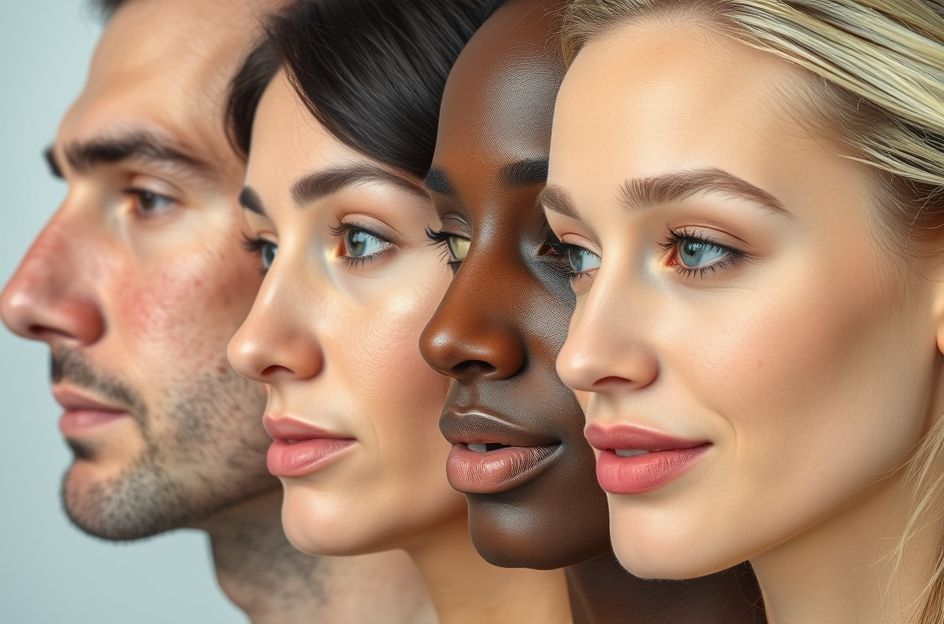Acne vulgaris can sometimes be accompanied by other skin conditions that are easily mistaken for it. Accurate diagnosis is crucial, as these conditions often require different treatments. While only a dermatologist can provide a definitive diagnosis, understanding these “acne imposters” can help you ask informed questions and seek appropriate care.
**Acne Cosmetica:** This mild form of acne is triggered by cosmetic products, affecting individuals regardless of their predisposition to acne. It manifests as small, itchy, pink bumps on the cheeks, chin, and forehead, developing gradually. To avoid it, choose “non-comedogenic” makeup and skincare products, which are less likely to clog pores.
**Dandruff (Seborrheic Dermatitis):** Often co-occurring with acne, particularly in adolescents, dandruff involves accelerated scalp-cell renewal in response to P. ovale, a common fungus. This results in flaking, scaling, and itching. Climate, heredity, diet, hormones, and stress can exacerbate dandruff. Manageable with over-the-counter shampoos containing zinc, coal tar, or salicylic acid. Avoid scratching the scalp, as this can worsen the condition.
**Dermatitis (Eczema):** Characterized by a rapidly spreading red, itchy rash with potential blisters and swelling. Atopic dermatitis is linked to asthma and allergies, while contact dermatitis arises from irritants or allergens. Chronic dermatitis presents as longstanding irritation, often affecting the eyelids, neck, and hands. Skin may be thickened and darker. This hereditary condition can be influenced by environmental factors.
**Enlarged Pores:** Pores tend to enlarge during adolescence due to increased sebum production and later in life from sun damage, which reduces skin elasticity. Genetics also play a significant role. Individuals with larger pores may notice grayish blackheads, which are simply normal sebum lining the pore. Squeezing these is futile and can damage the pore, causing permanent enlargement.
**Epidermal Cysts:** Unlike cystic acne, epidermal cysts are sac-like growths in the deeper skin layers filled with a soft, whitish material. Small cysts are generally harmless, but larger cysts can become infected, leading to pain and scarring. Removal of the entire cyst sac is often necessary to prevent recurrence. Consult a physician for any suspicious lumps or bumps.
**Favre-Racouchet Syndrome:** Caused by long-term sun damage, this condition primarily affects individuals over 50. It presents as large blackheads around the eyes and on the upper cheeks. These comedones require surgical extraction or topical retinoid treatment.
**Keratosis Pilaris:** Common in teenagers, this condition is characterized by patches of tiny, red, hard bumps on the arms, shoulders, buttocks, and thighs. It is usually painless and feels spiny. Symptoms worsen in winter and arid climates.
**Milia:** These tiny, white, hard bumps are found mainly around the eyes. They can persist for weeks or months, and a dermatologist can safely remove them if they are bothersome.
**Peri-Oral Dermatitis:** Affecting primarily women in their 20s and 30s, this condition causes itchy, red spots around the mouth. The skin bordering the lips may appear pale and dry, while the chin, upper lips, and cheeks become red, dry, and flaky. It can also affect the skin around the nose.
**Pseudofolliculitis Barbae (Shaving Bumps):** Occurs when hairs get trapped inside follicles after shaving, waxing, or plucking. Those with curly hair are more susceptible. Prevent by using an electric razor or a new, single-edge blade, shaving with the grain, and applying a mild toner or antibacterial gel after shaving.
**Rosacea:** Often mistaken for acne, rosacea primarily affects adults between 30 and 60. Unlike acne vulgaris, rosacea does not involve comedones and appears on areas that flush easily. The skin is bumpy, red, and oily, and may involve papules and pustules. Early treatment is essential to prevent chronic inflammation and scarring.
